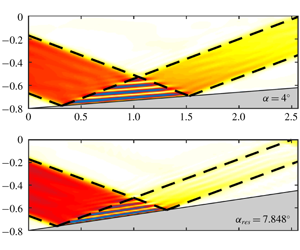Published online by Cambridge University Press: 30 January 2020

The nonlinear reflection of a finite-width plane internal gravity wave incident onto a uniform slope is addressed, relying on the inviscid theory of Thorpe (J. Fluid Mech., vol. 178, 1987, pp. 279–302) for pure plane waves. The aim of this theory is to determine the conditions under which the incident and the reflected waves form a resonant triad with the second-harmonic wave resulting from their interaction. Thorpe’s theory leads to an indeterminacy of the second-harmonic wave amplitude at resonance. In waiving this indeterminacy, we show that the latter amplitude has a finite behaviour at resonance, increasing linearly from the slope. We investigate the influence of background rotation and find similar results with a weaker growth rate. We then adapt the theory to the case of an incident plane wave of finite width. In this case, nonlinear interactions are confined to the area where the incident and reflected finite-width waves superpose, implying that the amplitude of the second-harmonic wave is bounded at resonance. We find good agreement with the results of numerical simulations in a vertical plane as long as the dissipated power of the incident and reflected waves remain smaller than the power transferred to the second-harmonic wave. This is the case for small slope angles. As the slope angle increases, the focusing of the reflected wave enhances viscous effects and dissipation eventually dominates over nonlinear transfer. We finally discuss the relevance of laboratory experiments to assess the validity of the theoretical results.